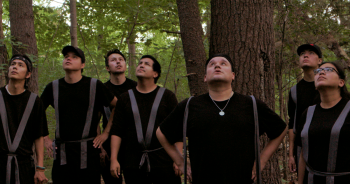Image Caption
Summary
Local Journalism Initiative Reporter
Windspeaker.com
After a COVID-19 hiatus, the Toronto Biennial of Art has returned for a second run after its 2019 debut.
The Biennial is a free art show with programs and about 80 exhibitions, including by Indigenous artists. It opened March 26 and can be viewed in venues throughout Toronto until June 5.
Artist Ange Loft’s video installation and collaborative performance called DISH DANCES is being shown at Fort York National Historic site. It showcases concepts from “around 1700” about First Nations land and “some of the trouble we have with kind of laying down rules for a specific territory.”
Loft is an interdisciplinary performing artist born in Kahnawake.
“DISH DANCES is kind of a multi-pronged project,” said Loft. “It's got a bunch of different aspects to the work. It's sort of an abstract, but also kind of an absurd play. A lot of it is told through movement.”
The result is a five-minute video on a loop projected across three screens featuring an all-Indigenous cast from the Toronto-based Centre For Indigenous Theatre. It can be seen Wednesday to Sunday from 10 a.m. to 4 p.m.
“Three videos that play a loop all together,” Loft explained. “It's a kind of fun take based on a bunch of research that we did about the use of the Credit River as a council site for many years, and is related to the story about the Dish with One Spoon (treaty). That would have been a place that the Mississaugas would have met up with a lot of the nations from across this whole region when they had their land still on the Credit River.”
Loft said there was no way the cast could fit in the full story of it within five minutes, but hopes the work will allow viewers to think critically about the performance’s subject matter.
“The nice thing about working with movement is that you can leave a lot to the audience's interpretation,” Loft said. “We were just playing really with actually some of those ideas about how you get rules across to another group of people in new territory.”
Another artist with work at the Biennial is Tanya Lukin Linklater, who is presenting what she calls a “four-channel video installation” in the “process of collaborative choreography”. It can be viewed at 2 Perth Ave in Toronto from 10 a.m. to 6 p.m. on Tuesday to Sunday and until 8 p.m. on Fridays.
Working remotely from four different dancers—Ivanie Aubin-Malo and Hanako Hoshimi-Caines in Montréal and Ceinwen Gobert and Emily Law in Toronto —through instruction and video equipment, the team composed recordings of their performances.
“The idea was that they would work for a maximum of two hours a week on this particular project in the generation of these small concise performances for camera.
“It was a kind of experiment,” Lukin Linklater said.
“In that instance, I was really trying to think about what was possible, given the constraints of the pandemic and given the sort of circumstances that we're all collectively living through.”
It was a positive experience to get to collaborate with other artists again, she said.
“Just to be around folks again, doing the work that I really enjoyed, it was fantastic,” Lukin Linklater said.
“So I'm really quite excited about the opening. I think people who are encountering these different works will have their own experience of the work.”
The Biennal’s description of Lukin Linklater’s work states that she “intervenes in the usual hierarchies that exist in museum and gallery spaces.”
“When I enter into those spaces, that's sort of at the centre of my first concern, is thinking about Indigenous peoples, our relationships to these institutions and these structures, and how they can perhaps better serve our peoples and communities,” Linklater explained.
Kohkom scarves are also a key part of Lukin Linklater’s work, used as part of a sculptural element of the presentation next to the video screens.
“To me it's a really strong symbol,” Lukin Linklater said of the fabric that ties the Ukraine and Indigenous peoples together. The scarves were given as gifts by Ukrainian settlers to First Nations peoples.
“It has a lot of political connotations, of course; is worn by jingle dancers and old-style fancy dancers, grass dancers, and at powwows. But it’s also worn by land defenders, Indigenous folks to various movements like Standing Rock or elsewhere.”
For more information about the performers and exhibits at the Toronto Biennial visit https://torontobiennial.org.

